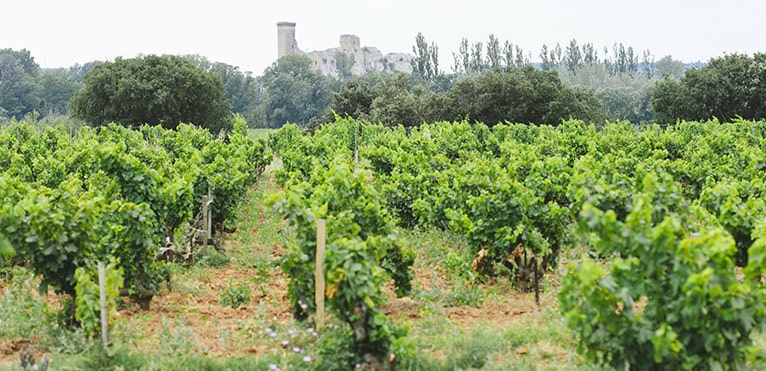
Contents
Châteauneuf-du-Pape has been an Appellation d’Origine Contrôlée (AOC) since 1936, and its wines are of the highest quality. Predominantly red at 94%, there are also whites produced in smaller quantities but just as renowned. Located in the southern part of the Rhône Valley, this appellation is one of 28 others in the Rhône Valley.
Châteauneuf-du-Pape, France’s leading AOC winegrowing region
The past of this appellation echoes its name, for it was thanks to the Popes settling in the region in the 14th century that full exploitation of ancient vineyard plots began. They also built the fortress that now dominates the appellation. It used to be their summer holiday home. For a very long time, the Popes ordered large quantities of Châteauneuf-du-Pape wines for their tables, earning these wines the name “Vin du Pape”. As a result, the reds and whites of this appellation soon became known to all the most influential people in Europe, and the reputation of these wines continued centuries later.
This reputation has enabled the appellation to develop and survive the various crises. The winegrowers who run it, led by Baron Le Roy, were behind the tightening of the Appellation d’Origine regulations, believing that such delimitation needed to be more rigorous to protect these French wines that are the envy of the world. This is how Châteauneuf-du-Pape became the first Appellation d’Origine Contrôlée wine in France.
Châteauneuf-du-Pape, wines full of aromas thanks to terroir and climate
The appellation’s vines are grown on 3,200 hectares at an altitude of almost 120 metres. Châteauneuf-du-Pape lies on the left bank of the Rhône between the Vacqueyras, Lirac and Côtes-du-Rhône-Villages AOCs. The soil consists mainly of red clay and rolled pebbles, giving the wines a high ageing potential and a rich aroma.
The terroir, and in particular the pebbles, also allow the vines to benefit from the heat of the day. Indeed, this is one of the hottest parts of the region, under the influence of a Mediterranean climate. That’s why the vines are goblet-pruned, protecting them from drought but also providing resistance to the strong Mistral wind. It’s also when wines are gorged with sunshine rather than rain that they become highly aromatic and powerful.
Châteauneuf-du-Pape, a divine wine made from 13 grape varieties
Châteauneuf-du-Pape owes its rich history to the use of 13 grape varieties: Bourboulenc, Clairette, Cinsault, Counoise, Grenache, Mourvèdre, Muscadin, Picardin, Picpoul, Roussanne, Syrah, Terret noir and Vaccarèse.
For the reds, over 70% of the blend is Grenache, giving the wine notes of red and black fruit and undergrowth that are generally easy to detect on the nose. We can also identify aromas of spices, chocolate and even animal nuances. As for the other grape varieties used, they vary enormously depending on the cuvée. due to the many possibilities for blending within the AOC. But the aromatic power of this wine, with its dark ruby color that is bright in its youth and more orangey with age, can be found on the palate of all cuvees. On the palate, rather dominant tannins and spicier aromas can also be detected. The ageing potential is significant: over 20 years for the best vintages, and much longer for exceptional vintages.
Châteauneuf-du-Pape whites are brilliant gold in color with green highlights. Less dense than the reds on the palate, this wine reveals its full roundness. On the nose, aromas of fruit and flowers mingle with notes of honey and wood as the wine ages. That’s right, it a wine for laying down that can be kept for up to 15 years.
Châteauneuf-du-Pape, a powerful wine that’s easy to enjoy
In general, beef and game go very well with Châteauneuf-du-Pape reds. In particular, dishes such as mushroom risotto or prime rib marinated with onions.
To accompany the whites, choose shellfish or fish such as roasted red mullet fillet, basil coulis and sautéed fennel. The ideal tasting temperature is 13°C.
2011, a banner year for Châteauneuf-du-Pape
1929, 1943, 1945, 1947, 1949, 1961, 1978, 1985, 1988, 1989, 1990, 1995, 1998, 2000, 2001, 2005, 2011 are the years to remember for Châteauneuf-du-Pape reds. But even more interesting for their superior quality are 1945, 1961, 1985, 2005 and 2000, considered to be the vintage of the century. As for the whites, 1961, 1978, 1989, 1990 and 1998 are considered crus du siècle.
Successful vintages for Châteauneuf-du-Pape whites are: 1929, 1945, 1947, 1978, 1983, 1985, 1989, 1990, 1995, 1998, 2005. For an exceptional tasting, 1947 and 1985 are the best years. But that’s without taking into account the 1929 vintage, which is a millennium vintage.
Châteauneuf-du-Pape, excellence through time
Château Gigognan
The estate owes its name to the legionnaire who inherited the land. Today, the estate covers more than 200 hectares. Since 2017, while ensuring exceptional wine quality, the owners have decided to develop wine tourism to enable the surrounding area to benefit economically from the renown of their wines.
Domaine de Beaurenard
This estate strives to produce wines in the ancestral tradition that has been handed down for 7 generations. The estate’s 32 hectares are devoted to Châteauneuf-du-Pape. Biodynamic viticulture is used not only to conserve the environment, but also to satisfy the family’s passion for wine.
Discover the best estates in Châteauneuf-du-Pape .